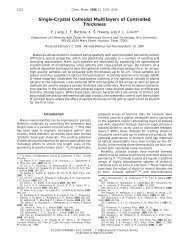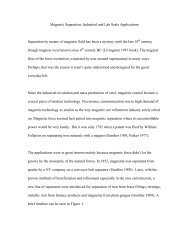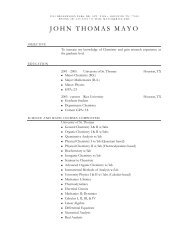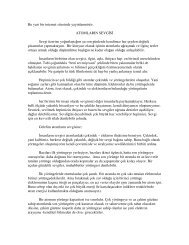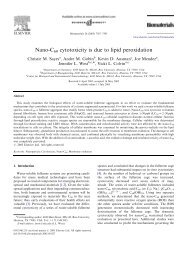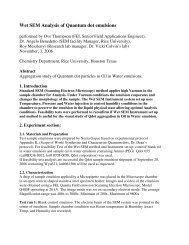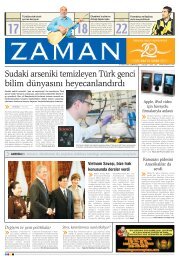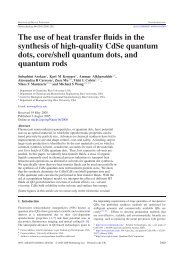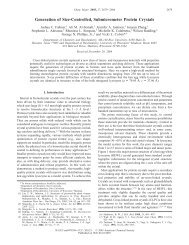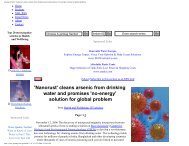Preparation and Characterization of Monodisperse ... - Rice University
Preparation and Characterization of Monodisperse ... - Rice University
Preparation and Characterization of Monodisperse ... - Rice University
Create successful ePaper yourself
Turn your PDF publications into a flip-book with our unique Google optimized e-Paper software.
3318 Chem. Mater. 2004, 16, 3318-3322<br />
<strong>Preparation</strong> <strong>and</strong> <strong>Characterization</strong> <strong>of</strong> <strong>Monodisperse</strong> PbSe<br />
Semiconductor Nanocrystals in a Noncoordinating<br />
Solvent<br />
William W. Yu, Joshua C. Falkner, Bertram S. Shih, <strong>and</strong> Vicki L. Colvin*<br />
Department <strong>of</strong> Chemistry, <strong>Rice</strong> <strong>University</strong>, 6100 Main Street, Houston, Texas 77005<br />
Received March 27, 2004. Revised Manuscript Received June 2, 2004<br />
Spherical PbSe semiconductor nanocrystals with near-infrared absorption <strong>of</strong> 1100-2520<br />
nm (corresponding to diameters <strong>of</strong> 3-13 nm) were synthesized in a noncoordinating solvent<br />
(1-octadecene). The as-prepared PbSe semiconductor nanocrystals have very narrow size<br />
distributions (σ = 5-7%) without any postsynthetic size selection. High-resolution transmission<br />
electron microscopy (TEM), electron diffraction, <strong>and</strong> X-ray diffraction show that the<br />
nanocrystalline particles are single domains <strong>of</strong> rock-salt PbSe. A water-soluble form <strong>of</strong> these<br />
materials was generated through simple surface treatments.<br />
Introduction<br />
Semiconductor nanocrystals have attracted great<br />
attention for their unique size-dependent behavior; their<br />
optical properties in particular differ greatly from the<br />
corresponding molecular <strong>and</strong> bulk materials. 1-3 Quantum<br />
confinement in nanocrystals leads to tunable blue<br />
shifts in both optical absorption <strong>and</strong> emission spectra<br />
with decreasing nanocrystal size. This phenomena has<br />
been extensively studied in monodisperse <strong>and</strong> sizecontrolled<br />
II-VI semiconductor nanocrystals (CdS, CdSe,<br />
<strong>and</strong> CdTe). 4-6 Many applications which rely on the size<br />
tunability <strong>and</strong> high quantum yields <strong>of</strong> these systems<br />
have also been proposed <strong>and</strong>, in some cases, developed<br />
into commercial products. 7-17<br />
Comparatively less is known about the related family<br />
<strong>of</strong> nanoscale lead chalocogenides. As direct gap semiconductors<br />
in the bulk phase, they should exhibit<br />
* Corresponding author. E-mail: colvin@rice.edu.<br />
(1) Alivisatos, A. P. J. Phys. Chem. B 1996, 100, 13226-13239.<br />
(2) Alivisatos, A. P. Science 1996, 271, 933.<br />
(3) Review articles on colloidal nanocrystals. Acc. Chem. Res. 1999,<br />
32, 387 (Special Issue for Nanostructures).<br />
(4) Peng, X.; Wickham, J.; Alivisatos, A. P. J. Am. Chem. Soc. 1998,<br />
120, 5343-5344.<br />
(5) Murray, C. B.; Norris, D. J.; Bawendi, M. G. J. Am. Chem. Soc.<br />
1993, 115, 8706-8715.<br />
(6) Peng, X.; Manna, L.; Yang, W. D.; J.Wickham; Scher, E.;<br />
Kadavanich, A.; Alivisatos, A. P. Nature 2000, 404, 59.<br />
(7) Quantum Dot Corporation, http://www.qdots.com.<br />
(8) Chan, W. C. W.; Nie, S. Science 1998, 281, 2016-2018.<br />
(9) Bruchez, M. Jr.; Moronne, M.; Gin, P.; Weiss, S.; Alivisatos, A.<br />
P. Science 1998, 281, 2013-2016.<br />
(10) Mattoussi, H. M., J. M.; Goodman, E.; Anderson, G. P.; Sundar<br />
V. C.; Mikulec, F. V.; Bawendi, M. G. J. Am. Chem. Soc. 2000, 122,<br />
12142.<br />
(11) Coe, S.; Woo, W.-K.; Bawendi, M. G.; Bulovic, V. Nature 2002,<br />
420, 800.<br />
(12) Colvin, V. L.; Schlamp, M. C.; Alivisatos, A. P. Nature 1994,<br />
370, 354.<br />
(13) Tessler, N.; Medvedev, V.; Kazes, M.; Kan, S.; Banin, U. Science<br />
2002, 295, 1506.<br />
(14) Klimov, V. I.; Mikhailovsky, A. A.; Xu, S. M., A.; Hollingsworth,<br />
J. A.; Leatherdale, C. A.; Eilser, H.-J.; Bawendi, M. G. Science 2000,<br />
290, 314.<br />
(15) Kazes, M.; Lewis, D. Y.; Ebenstein, Y.; Mokari, T.; Banin, U.<br />
Adv. Mater. 2002, 14, 317.<br />
(16) Huynh, W. U. D., J. J.; Alivisatos, A. P. Nature 2002, 295, 2425.<br />
(17) Eisler, H.-J.; Sundar, V. C.; Bawendi, M. G.; Walsh, M.; Smith,<br />
H. I.; Klimov, V. I. Appl. Phys. Lett. 2002, 80, 4614.<br />
similar size-dependent behavior to the cadmium systems;<br />
however, the very large Bohr radii in lead materials<br />
(20-46 nm), as compared to cadmium systems (4-<br />
10 nm), permits their optical properties to be evaluated<br />
in the limit <strong>of</strong> extremely strong quantum confinement. 18<br />
In this regime, theoretical predictions <strong>of</strong> both maximum<br />
absorbance as well as oscillator strength are at odds<br />
with experimentally measured values. 19 Additionally,<br />
lead chalcogenide nanocrystals emit near-infrared (NIR)<br />
light, <strong>and</strong> their high nonlinearities make them excellent<br />
materials for optical switches. 18 The near-infrared emission<br />
is also an ideal property for biological imaging;<br />
tissue has a window in absorbance between 700 <strong>and</strong><br />
1150 nm, which makes NIR labels <strong>of</strong> special importance.<br />
20 Near-infrared emitting nanocrystals could in<br />
principle be applied to in vivo biomedical application<br />
(imaging <strong>and</strong> labeling) where detection may occur<br />
through 1-20 mm <strong>of</strong> tissues. 20-22<br />
In contrast to the cadmium chalcogenide nanocrystals,<br />
production <strong>of</strong> lead chalcogenide semiconductor<br />
nanocrystals (PbS, PbSe, <strong>and</strong> PbTe) has only recently<br />
been explored. 23-27 Lead chalcogenide semiconductor<br />
nanocrystals were first generated inside polymer <strong>and</strong><br />
oxide glass hosts over a decade ago. 28,29 A more versatile<br />
liquid-phase synthesis for PbSe colloidal nanocrystals<br />
was first reported by Murray et al. in 2001. 25 In the<br />
(18) Wise, F. W. Acc. Chem. Res. 2000, 33, 773-780.<br />
(19) Yu, W. W.; Qu, L.; Guo, W.; Peng, X. Chem. Mater. 2003, 15,<br />
2854-2860.<br />
(20) Lim, Y. T.; Kim, S.; Nakayama, A.; Stott, N. E.; Bawendi, M.<br />
G.; Frangioni, J. V. Mol. Imaging 2003, 2, 50-64.<br />
(21) Richards-Kortum, R.; Drezek, R.; Sokolov, K.; Pavlova, I.;<br />
Follen, M. In H<strong>and</strong>book <strong>of</strong> Biomedical Fluorescence; Mycek, M.-A.,<br />
Pogue, B. W., Eds.; Marcel Dekker, Inc.: New York, 2003, pp 237-<br />
264.<br />
(22) Weissleder, R. Nat. Biotechnol. 2001, 19, 316-317.<br />
(23) Sashchiuk, A.; Langol, L.; Chaim, R.; Lifshitz, E. J. Cryst.<br />
Growth 2002, 240, 431-438.<br />
(24) Lifshitz, E.; Bashouti, M.; Kloper, V.; Kigel, A.; Eisen, M. S.;<br />
Berger, S. Nano Lett. 2003, 3, 857-862.<br />
(25) Murray, C. B.; Sun, S.; Gaschler, W.; Doyle, H.; Betley, T. A.;<br />
Kagan, C. R. IBM J. Res. Dev. 2001, 45, 47-55.<br />
(26) Wehrenberg, B. L.; Wang, C.; Guyot-Sionnest, P. J. Phys.<br />
Chem. B 2002, 106, 10634-10640.<br />
(27) Du, H.; Chen, C.; Krishnan, R.; Krauss, T. D.; Harbold, J. M.;<br />
Wise, F. W.; Thomas, G.; Silcox, J. Nano Lett. 2002, 2, 1321-1324.<br />
10.1021/cm049476y CCC: $27.50 © 2004 American Chemical Society<br />
Published on Web 07/17/2004
<strong>Monodisperse</strong> PbSe Semiconductor Nanocrystals Chem. Mater., Vol. 16, No. 17, 2004 3319<br />
following year, Guyot-Sionnest, 26 Krauss, 27 <strong>and</strong> their coworkers<br />
simultaneously reported similar methods to<br />
prepare PbSe semiconductor colloidal nanocrystals. Very<br />
small PbSe nanocrystals (d ) 2-3 nm) 23 as well as<br />
larger PbSe quantum wires, rods, <strong>and</strong> cubes 24 have also<br />
been recently reported.<br />
Here, we report our study which uses a noncoordinating<br />
solvent to synthesize PbSe nanocrystals. Analogous<br />
to nanocrystalline CdSe, a noncoordinating solvent permits<br />
the formation <strong>of</strong> a larger size range <strong>of</strong> PbSe nanoparticles<br />
in a cheap <strong>and</strong> environmentally friendly solvent.<br />
19,30,31 Moreover, the reaction yields materials<br />
equivalent in quality to current cadmium chalcogenide<br />
materials. Typical size distributions are between 5 <strong>and</strong><br />
7% prior to any size-selective treatments. The near-infrared<br />
absorption <strong>of</strong> these materials ranges from 1100 to<br />
2520 nm (corresponding to diameters <strong>of</strong> 3-13 nm) <strong>and</strong><br />
a strong (QY > 85%) NIR emission is observed. Finally,<br />
we demonstrate a simple method for transferring the<br />
as-made organically soluble materials into water.<br />
Experimental Section<br />
Materials. Lead oxide (99.999%), oleic acid (90%), selenium<br />
(99.5%, 100 mesh), trioctylphosphine (90%), 1-octadecene<br />
(90%), tetrachloroethylene (99%), <strong>and</strong> 11-mercaptoundecanoic<br />
acid (95%) were purchased from Aldrich. Chlor<strong>of</strong>orm, methanol,<br />
hexane, toluene, <strong>and</strong> acetone were obtained from Fisher.<br />
Synthesis. PbSe semiconductor nanocrystals were synthesized<br />
in a three-neck flask equipped with condenser, magnetic<br />
stirrer, thermocouple, <strong>and</strong> heating mantle. Typically, a mixture<br />
<strong>of</strong> 0.892 g <strong>of</strong> PbO (4.00 mmol), 2.825 g <strong>of</strong> oleic acid (10.00<br />
mmol), <strong>and</strong> technological grade 1-octadecene (ODE) (the total<br />
weight was 16 g) turned colorless upon heating to around 150<br />
°C; the mixture was further heated to 180 °C. Then, 6.4 g <strong>of</strong><br />
selenium-trioctylphosphine solution (containing 0.64 g <strong>of</strong><br />
selenium, 8.00 mmol) was quickly injected into this hot<br />
solution; the temperature <strong>of</strong> the reaction mixture was allowed<br />
to cool to 150 °C for the growth <strong>of</strong> the PbSe semiconductor<br />
nanocrystals. All steps in the reactions were carried out under<br />
argon. The nanocrystal growth process here is continuous. In<br />
a typical reaction, monodisperse 3.5-nm particles were recovered<br />
after only 10 s at 150 °C; the yields for these smaller<br />
particles were low as much <strong>of</strong> the starting material remained<br />
unreacted. Longer time treatments, <strong>of</strong> for example 800 s,<br />
provided nearly 100% yields <strong>of</strong> 9.0-nm nanocrystals.<br />
<strong>Characterization</strong>. A Varian Cary 5000 UV-Vis-NIR<br />
spectrophotometer was used to monitor the reaction; aliquots<br />
<strong>of</strong> the solution were removed at different time intervals with<br />
a syringe. A Jobin Yvon Spex Fluorolog 3-211 Fluorescence<br />
spectrophotometer was used to obtain photoluminescence<br />
spectra. X-ray diffraction patterns were recorded by powder<br />
diffraction using a Siemens Platform-Model General Area<br />
Detector Diffraction System (GADDS) with a Cu KR source.<br />
The powder samples were run with an internal silicon powder<br />
st<strong>and</strong>ard in order to account for instrumental line broadening.<br />
TEM specimens were made by evaporating one to two drops<br />
<strong>of</strong> reaction solution onto carbon-coated copper grids. The TEM<br />
micrographs were taken by a JEOL FasTEM 2010 transmission<br />
electron microscope operating at 100 kV. The size <strong>and</strong><br />
size distribution data were obtained by measuring about<br />
10000-15000 individual PbSe nanocrystalline particles using<br />
Image-Pro Plus 5.0 (Media Cybernetics Inc.). The microscope<br />
(28) Bakueva, L.; Musikhin, S.; Hines, M. A.; Chang, T.-W. F.;<br />
Tzolov, M.; Scholes, G. D.; Sargent, E. H. Appl. Phys. Lett. 2003, 82,<br />
2895-2897.<br />
(29) Lipovskii, A.; Kolobkova, E.; Petrikov, V.; Kang, I.; Olkhovets,<br />
A.; Krauss, T.; Thomas, M.; Silcox, J.; Wise, F.; Shen, Q.; Kycia, S.<br />
Appl. Phys. Lett. 1997, 71, 3406-3408.<br />
(30) Yu, W. W.; Peng, X. Angew. Chem., Int. Ed. 2002, 41, 2368.<br />
(31) Yu, W. W.; Wang, Y. A.; Peng, X. Chem. Mater. 2003, 15, 4300-<br />
4308.<br />
was carefully calibrated by st<strong>and</strong>ard samples to avoid any<br />
systematic error due to incorrect magnification adjustments.<br />
Purification. It should be pointed out that ODE <strong>and</strong> oleic<br />
acid, which show strong absorption in NIR, must be removed<br />
from the original aliquots taken from the reaction flask before<br />
the absorption measurement. The aliquot was swiftly taken<br />
out <strong>and</strong> quenched by room-temperature chlor<strong>of</strong>orm. The<br />
chlor<strong>of</strong>orm solution was extracted twice with an equal volume<br />
<strong>of</strong> methanol; then the ODE phase was mixed with excess<br />
acetone to totally precipitate PbSe semiconductor nanocrystals.<br />
The precipitated PbSe semiconductor nanocrystals were redispersed<br />
in chlor<strong>of</strong>orm or hexane <strong>and</strong> were precipitated again<br />
by excess acetone. The purified PbSe semiconductor nanocrystals<br />
(solid state) were finally dispersed in tetrachloroethylene<br />
for NIR absorbance <strong>and</strong> other characterizations. During<br />
the purification process, the PbSe semiconductor nanocrystals<br />
were completely recovered, <strong>and</strong> there was no size selection<br />
applied to the sample.<br />
Results <strong>and</strong> Discussion<br />
The advantages <strong>of</strong> using a noncoordinating solvent<br />
in producing semiconductor nanocrystals have been<br />
illustrated for a wide range <strong>of</strong> materials. 19,30-34 This<br />
method not only eliminates the extremely toxic organometallic<br />
precursors <strong>and</strong> most phosphine-containing<br />
solvents used in other methods but also dramatically<br />
decreases the cost <strong>of</strong> high-quality semiconductor nanocrystals.<br />
On the basis <strong>of</strong> the success <strong>of</strong> noncoordinating<br />
solvents in producing other high-quality nanocrystals,<br />
we adopted many <strong>of</strong> these existing methods when<br />
producing PbSe. Lead oxide was used as a lead source,<br />
<strong>and</strong> at 150 °C this material forms lead oleate with oleic<br />
acid; the injection <strong>of</strong> selenium (trioctylphosphine as<br />
solvent) at 180 °C starts the nucleation <strong>of</strong> PbSe. With<br />
lowering <strong>of</strong> the reaction temperature immediately after<br />
injection, no further nucleation occurs in the reaction.<br />
The temperature remains high enough to permit the<br />
nuclei to grow until soluble lead is consumed.<br />
A transmission electron micrograph <strong>of</strong> the sample<br />
(Figure 1) reveals that the nanocrystals develop as<br />
highly monodisperse materials without the need for size<br />
selection. The as-synthesized PbSe semiconductor nanocrystals<br />
are generally spherical dots; the size distribution<br />
is very narrow, typically 5-7% except when diameters<br />
exceed 10 nm (>10 nm, 10-15% st<strong>and</strong>ard deviation).<br />
High-resolution TEM micrographs <strong>of</strong> the PbSe nanocrystals<br />
(Figure 2) show that these nanocrystals are<br />
single crystals without detectable stacking faults or<br />
crystal defects. In contrast to existing reports <strong>of</strong> larger<br />
PbSe crystals, we always find spherical dots even up to<br />
the largest sizes (13 nm). 24 Electron diffraction (Figure<br />
3) <strong>and</strong> X-ray diffraction patterns (Figure 4) <strong>of</strong> the<br />
sample confirm that the nanocrystals are a perfect rocksalt<br />
crystal structure. The size calculated from line<br />
broadening by the Scherrer equation is 5.7 nm, which<br />
is very close to the measured diameter from TEM<br />
observation <strong>of</strong> the same sample (5.9 nm). Table 1 <strong>and</strong><br />
Table 2 give the observed reflections from electron <strong>and</strong><br />
X-ray diffraction. The calculated values <strong>of</strong> d spacing,<br />
diffraction angle, <strong>and</strong> intensity are in excellent agreement<br />
with the cubic (rock salt) structure <strong>of</strong> bulk PbSe. 35<br />
As in all quantum dot systems, PbSe nanocrystals<br />
exhibit a blue shift in absorption with decreasing size.<br />
(32) Battaglia, D.; Peng, X. Nano Lett. 2002, 2, 1027-1030.<br />
(33) Li, J. J.; Wang, Y. A.; Guo, W.; Keay, J. C.; Mishima, T. D.;<br />
Johnson, M. B.; Peng, X. J. Am. Chem. Soc. 2003, 125, 12567-12575.<br />
(34) Battaglia, D.; Li, J. J.; Wang, Y.; Peng, X. Angew. Chem., Int.<br />
Ed. 2003, 42, 5035-5039.
3320 Chem. Mater., Vol. 16, No. 17, 2004 Yu et al.<br />
Figure 1. TEM photograph (left) <strong>and</strong> histogram (right) <strong>of</strong> the as-prepared PbSe semiconductor nanocrystals. The PbSe<br />
semiconductor nanocrystal sample shown here has an average diameter <strong>of</strong> 6.8 nm with a very narrow size distribution (σ )<br />
6.2%).<br />
Figure 2. High-resolution TEM photographs <strong>of</strong> individual<br />
PbSe semiconductor nanocrystals. The single-crystal structure<br />
is clearly apparent. The white bar in the left-bottom corner is<br />
5 nm.<br />
Figure 3. Electron diffractogram <strong>of</strong> the PbSe nanocrystals.<br />
These rings index well to rock-salt PbSe (Table 1).<br />
Figure 5 illustrates the size-dependent spectra <strong>of</strong> various-sized<br />
PbSe semiconductor nanocrystals. Welldefined<br />
peaks, which reflect the narrow size distribution,<br />
are readily apparent. The first absorption peak<br />
ranges from 1100 to 2520 nm, which is the widest<br />
available range to date; the HWHM (half width at half<br />
maximum to the long wavelength side <strong>of</strong> the first<br />
absorption peak position) 19 is 55-65 nm except for very<br />
large sizes (9-13 nm). The HWHM in the existing<br />
preparations for PbSe are above 70 nm, except Murray’s<br />
(35) McClune, W. F. Powder Diffraction File Alphabetical Index<br />
Inorganic Phase; JCPDS: Swarthmore, PA, 1980.<br />
Figure 4. X-ray diffraction pattern <strong>of</strong> 5.9-nm PbSe nanocrystals<br />
indexed to the bulk rock-salt crystal structure. The<br />
sample’s crystal size as calculated from line broadening by the<br />
Scherrer equation is 5.7 nm.<br />
Table 1. Interplanar Spacings Obtained by the Electron<br />
Diffractogram <strong>of</strong> the PbSe Nanocrystals<br />
radius <strong>of</strong><br />
diffraction circle<br />
(mm)<br />
calculated<br />
value <strong>of</strong> d<br />
(Å)<br />
d <strong>of</strong> PbSe phase<br />
from ref 35 hkl<br />
6.28 3.5 3.54 111<br />
7.23 3.0 3.06 200<br />
10.26 2.1 2.165 220<br />
12.11 1.8 1.846 311<br />
12.80 1.7 1.768 222<br />
14.54 1.5 1.531 400<br />
16.25 1.4 1.369 420<br />
17.75 1.2 1.250 422<br />
55-60 nm in the narrow peak position range <strong>of</strong> 1600-<br />
1750 nm. 25 It should be noted that our results are based<br />
on total recovery <strong>of</strong> the entire sample.<br />
The size distribution <strong>of</strong> PbSe nanocrystals changes<br />
as the reaction proceeds. It can be seen from Figure 6<br />
that the size distribution is broad at the beginning <strong>of</strong><br />
the reaction (HWHM is used here as a convenient index<br />
<strong>of</strong> size distribution), but quickly narrows to a stable<br />
value <strong>of</strong> 55 nm. This is a “focusing” <strong>of</strong> the size distribution<br />
similar to that reported by Peng et al. 4 After several<br />
minutes the particle size distribution increases due to<br />
the depletion <strong>of</strong> the monomers in the reaction solution;<br />
this is the result <strong>of</strong> defocusing <strong>of</strong> the size distribution<br />
(Ostwald ripening). <strong>Monodisperse</strong> particles are formed<br />
in this reaction because the nucleation process is limited
<strong>Monodisperse</strong> PbSe Semiconductor Nanocrystals Chem. Mater., Vol. 16, No. 17, 2004 3321<br />
Figure 5. Near-infrared absorption spectra <strong>of</strong> as-prepared<br />
PbSe semiconductor nanocrystals. Four to five features (states)<br />
are distinctly resolved.<br />
Figure 6. Size distribution variation over the course <strong>of</strong> the<br />
reaction. The reaction started with 4.00 mmol <strong>of</strong> PbO, 8.50<br />
mmol <strong>of</strong> oleic acid, 12.283 g <strong>of</strong> ODE, <strong>and</strong> 8.00 mmol <strong>of</strong> Se (with<br />
5.76 g <strong>of</strong> trioctylphosphine) at 180 °C; the final growth<br />
temperature was 150 °C.<br />
Table 2. Comparison <strong>of</strong> X-ray Diffraction Experimental<br />
Results with Bulk Structure <strong>of</strong> PbSe<br />
literature result from ref 35 this work<br />
d value<br />
(Å) hkl<br />
2θ<br />
(deg)<br />
intensity<br />
(%)<br />
2θ<br />
(deg)<br />
intensity<br />
(%)<br />
3.54 111 25.1 30 25.2 20.5<br />
3.06 200 29.2 100 28.8 100<br />
2.165 220 41.7 70 41.2 62.1<br />
1.84 311 49.5 18 48.5 23.5<br />
1.768 222 51.7 20 51.0 27.3<br />
1.531 400 60.4 14 59.9 11.4<br />
1.405 331 66.5 6 65.7 9.9<br />
1.369 420 68.5 25 68.0 31.1<br />
1.25 422 76.1 16 75.6 25.8<br />
1.179 511 81.6 4 80.8 9.2<br />
1.082 540 90.8 6 90.1 11.4<br />
to the brief injection period; the lower temperature<br />
growth occurs slowly <strong>and</strong> relies predominantly on lead<br />
monomers provided at the start <strong>of</strong> the reaction rather<br />
than the dissolution <strong>of</strong> smaller particles.<br />
We also evaluated the relationship <strong>of</strong> the first absorption<br />
peak (Figure 5) to the nanocrystal size <strong>and</strong> compared<br />
it to other published data (Figure 7). In developing<br />
this relationship, both the methods used to size <strong>and</strong><br />
stabilize particles received great attention so as to<br />
minimize error. First, all samples were immediately<br />
purified after they were taken out from the reaction<br />
flask, <strong>and</strong> the measurement <strong>of</strong> the absorption spectra<br />
<strong>and</strong> the TEM sample preparation were quickly completed.<br />
This prevented etching <strong>and</strong>/or oxidation <strong>of</strong><br />
particles in air. Additionally, the size <strong>and</strong> size distribution<br />
data were obtained by using Image-Pro Plus 5.0<br />
s<strong>of</strong>tware to count 10000-15000 individual PbSe nanocrystalline<br />
particles. The individual particles were measured<br />
from 4 to 6 TEM micrographs from different areas<br />
on one grid specimen; this greatly reduced the possible<br />
error generated from nonuniform drying <strong>of</strong> particles. As<br />
the s<strong>of</strong>tware requires a number <strong>of</strong> judgments in the data<br />
processing regarding the thresholding <strong>and</strong> filtering <strong>of</strong><br />
images, the data reported in Figure 7 show the results<br />
for the independent analysis by two individuals. There<br />
is good agreement between the two data sets. Finally,<br />
to ensure this sizing curve is accurate, multiple samples<br />
with the same first absorption peak wavelength were<br />
compared. There is little difference (1.7% maximum) in<br />
size between different reaction batches.<br />
The data shown in Figure 7 were collected from five<br />
different sources including our own. 23,25-27 Kang <strong>and</strong><br />
Wise 36 performed a four-b<strong>and</strong> envelope function calculation<br />
<strong>of</strong> the electronic structures <strong>of</strong> PbSe nanocrystals.<br />
The theoretical results were also plotted in Figure 7<br />
(symbol with ×), which <strong>of</strong>fset our data by 1.5-2.5 nm.<br />
In contrast to the well-studied CdSe semiconductor<br />
nanocrystal materials, the size versus absorption peak<br />
data from different studies are not in perfect agreement.<br />
While there is reasonable agreement from 1000 to 1400<br />
nm (first absorption peak position), more substantial<br />
variations are observed beyond 1500 nm. Such differences<br />
may be due to experimental factors associated<br />
with particle stabilization or sizing. Alternatively, we<br />
note that PbSe is a material which exhibits much<br />
stronger quantum confinement than CdSe, due to the<br />
large exciton diameter in the bulk material. In this case,<br />
the relationship between particle diameter <strong>and</strong> optical<br />
absorption properties would not be universal for all<br />
reaction strategies; however, the differences should be<br />
more pronounced at smaller sizes in contrast to our data<br />
which show greater differences at larger sizes. Alternatively,<br />
subtle changes in crystal habit or shape at<br />
larger sizes in different preparations could lead to<br />
variations in the optical absorption spectrum.<br />
The as-synthesized PbSe semiconductor nanocrystals<br />
have a strong near-infrared emission. Figure 8 shows<br />
the absorption <strong>and</strong> emission spectra <strong>of</strong> one sample. The<br />
first absorption peak position is 1205 nm (HWHM is<br />
56 nm); the emission (PL, photoluminescence) peak<br />
position is 1235 nm (fwhm (full width at half maximum<br />
<strong>of</strong> the emission spectrum peak) <strong>of</strong> PL is 145 nm). There<br />
is a 30-nm Stokes shift. The PL spectrum is also a<br />
perfect Gaussian shape <strong>and</strong> clearly indicates a pure<br />
b<strong>and</strong>-gap emission. The quantum efficiency was measured<br />
as 89% for this sample using IR-26 as a reference,<br />
26 which is similar to reported results for PbSe. 26,27<br />
This result is typical for the smaller lead selenide<br />
particles (d < 4.5 nm); similar experiments on larger<br />
near-infrared quantum dots are underway.<br />
(36) Kang, I.; Wise, F. W. J. Opt. Soc. Am. B 1997, 14, 1632-1646.
3322 Chem. Mater., Vol. 16, No. 17, 2004 Yu et al.<br />
Figure 7. Diameter <strong>of</strong> semiconductor nanocrystals versus the position <strong>of</strong> the first absorption peak. Data were taken from this<br />
work as well as other recently published reports. The open <strong>and</strong> solid circles are from two individuals’ independent measurements<br />
<strong>and</strong> demonstrate that little systematic error is introduced in the sizing process.<br />
Figure 8. Absorption <strong>and</strong> emission (PL) spectra <strong>of</strong> 3.9-nm<br />
PbSe semiconductor nanocrystals. The narrow near-infrared<br />
emission is pure b<strong>and</strong>-gap emission with a quantum efficiency<br />
<strong>of</strong> 89%.<br />
The as-prepared PbSe are oleate-stabilized nanocrystals<br />
<strong>and</strong> are soluble in organic solvents such as toluene,<br />
chlor<strong>of</strong>orm, <strong>and</strong> hexane. However, for biological imaging<br />
applications water-soluble materials are essential. It is<br />
straightforward to make water-soluble PbSe semiconductor<br />
nanocrystals through exchange <strong>of</strong> hydrophobic lig<strong>and</strong>s<br />
for hydrophilic lig<strong>and</strong>s. Here, water-soluble PbSe semiconductor<br />
nanocrystals were successfully obtained by<br />
using 11-mercaptoundecanoic acid as the new capping<br />
lig<strong>and</strong> following a method developed for CdSe. 37 Figure<br />
9 shows clearly the transfer <strong>of</strong> the black PbSe nanocrystal<br />
material from the oil phase to the water phase<br />
after this exchange process. The absorption <strong>and</strong> photoluminescence<br />
spectra <strong>of</strong> these nanoscale PbSe’s in water<br />
are unchanged from that <strong>of</strong> the original materials;<br />
however, the quantum yield <strong>of</strong> emission falls somewhat<br />
in water, to 35% from 89%. While these materials are<br />
stable in pure water, in some biological buffers the<br />
materials do not remain in solution. Optimization <strong>of</strong><br />
(37) Aldana, J.; Wang, Y. A.; Peng, X. J. Am. Chem. Soc. 2001, 123,<br />
8844-8850.<br />
Figure 9. Water-soluble PbSe semiconductor nanocrystals.<br />
Initially, the materials are soluble in organic solvents, as<br />
shown on the left where the organic phase has a distinctive<br />
brown-black color due to the presence <strong>of</strong> PbSe nanocrystals.<br />
The material can be derivatized for water solubility as is shown<br />
on the right, where the colored nanocrystals are now in the<br />
aqueous phase.<br />
these surface-capping strategies, <strong>and</strong> a more detailed<br />
study on the application <strong>of</strong> these water-soluble NIR<br />
emitters to in vivo biological applications, is underway.<br />
Conclusion<br />
<strong>Monodisperse</strong> PbSe semiconductor nanocrystals with<br />
a rock-salt structure were successfully synthesized in<br />
a noncoordinating solvent. The high quality, wide optical<br />
absorption range, <strong>and</strong> high quantum efficiency <strong>of</strong> the<br />
as-prepared PbSe semiconductor nanocrystals illustrate<br />
the value <strong>of</strong> using noncoordinating solvents in chalcogenide<br />
syntheses.<br />
Acknowledgment. We would like to thank Dr.<br />
Sergei M. Bachilo <strong>and</strong> Dr. R. Bruce Weisman for the<br />
use <strong>of</strong> the Jobin Yvon Spex Fluorolog 3-211 Fluorescence<br />
spectrophotometer. This work was financially supported<br />
by the National Science Foundation through the Center<br />
for Biological <strong>and</strong> Enviromental Nanotechnology [EEC-<br />
0118007], <strong>and</strong> the Robert A. Welch Foundation [C-1349].<br />
CM049476Y



